 |
 |
Photo of the Day: OCR UpdateJanuary 24 - Miami, FL 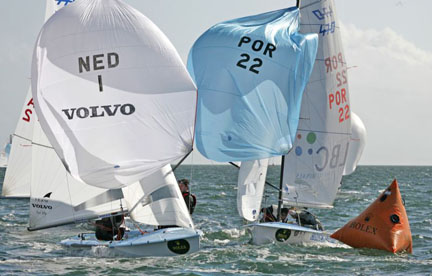 Dueling 470s on the first day of racing at the Rolex Miami OCR. This year's event will help determine national and world rankings and, for some countries, the actual teams that will attend the 2008 Olympics. Photo Dan Nerney/Rolex After one day of picture-perfect conditions and one day of barely a whisper of wind on Biscayne Bay, the 855 sailors competing at the Rolex Miami Olympic Classes Regatta are settling into their routines. Light wind meant racing on Tuesday was postponed in the morning for all 14 classes and canceled altogether for the Tornados. A moderate breeze has returned today. While it's still early in the regatta, a few familiar names are rising to the top of their classes: Paige Railey leads the Laser Radials; the team of Sally Barkow/Carrie Howe/Debbie Capozzi is in second in the Ynglings; Fredrick Loof and Anders Ekstrom of Sweden top the Stars, as does Tim Wadlow with crew Christopher Rast in the 49ers. Of the NorCal boats, after three races in the Laser Radial fleet, Claire Dennis is in a three-way tie for 21st with a second-place finish in the most recent race. Katie Maxim sits in 23rd in the 69-boat fleet. In the women's 470, Molly Carapiet and Molly O'Bryan are in 15th overall, but hold the third U.S. team position after seven races. (A top three U.S. finish at RMOCR qualifies sailors for the U.S. Sailing Team.) Morgan Larson and Pete Spaulding had a DNF in race 3 putting them 17th in the 47-boat 49er fleet after 4 races. (They'll be able to drop the DNF after race 5). Also racing in the 49ers, John Heineken and Matt Noble are 39th. Peter Vessella holds 40th in the 67-boat Star fleet (after 3 races), Andras Nady of Berkeley is in 47th in the Finns (4 races) and Caleb Everett is 101st in the Laser fleet (4 races). For complete results and daily summaries, go to www.rolexmiamiocr.org. - latitude / ss |
Spartan Cruising: Where Are They Now?January 24 - Coral Bay, USVI As an indicator of how cruising has changed over the years, here are two images of the tiny Cowhorn schooner Sunspirit, shot in Coral Bay, U.S. Virgin Islands, in the early '80s. The young couple - whose names have escaped our memories - had sailed her down from New England and were happily living board. She was roughly six months pregnant at the time, and their spartan little craft had absolutely no modern amenities, but they always seemed to be smiling. 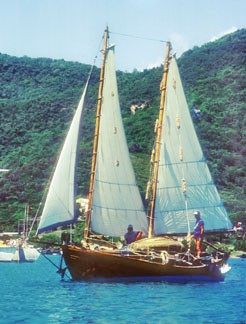 Although the scale of Sunspirit makes her look like a toy, she was a cozy home to this young couple during the early '80s. 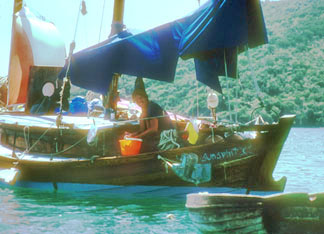 Note the freeboard! Life aboard was simple, yet joyous. Photos Latitude/Andy If this rings a bell with any of you out there in cyberspace, we'd love to hear about Sunspirit's further adventures and to get an answer to the question, "Where are they now?" - latitude / aet |
'Real' Reality ShowsJanuary 24 - Sausalito and Menlo Park If you're into reality shows, you might be interested in catching a couple of 'real' reality shows tomorrow night. The Richardson's Bay Maritime Association (RBMA) will be hosting a presentation at the Spaulding Wooden Boat Center in Sausalito about the museum-quality restoration of Freda. The 32-ft gaff sloop is the oldest active sailboat on the West Coast and is considered by many to be the "matriarch of San Francisco Bay." The talk starts at 7 p.m. and is free but donations are welcome. Check www.spauldingcenter.org or www.rbma.net to find out what else they're up to. 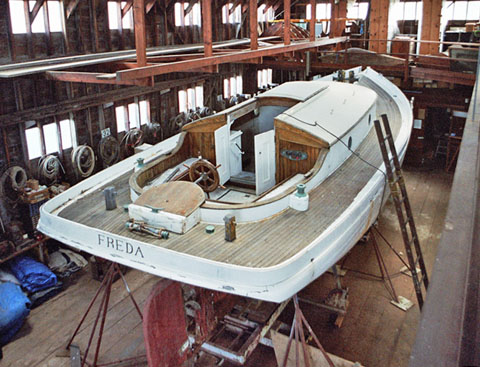 Freda, the "matriarch of San Francisco Bay" Photo Courtesy Spaulding Wooden Boat Center At the other end of the Bay, the U.S. Geological Survey is presenting "The Hidden World of the Golden Gate," a free lecture on how tides, currents and humans have created an array of sea-floor features. The talk will be held at 7 p.m. in Conference Room A of Building Three at the Menlo Park Science Center. See http://online.wr.usgs.gov/calendar for more info. - latitude / ld |
The Biggest Fiasco in Bay Area HistoryJanuary 24 - San Francisco And this one has nothing to do with the latest decision of the San Francisco Board of Supervisors. We're talking about the incredibly popular Three Bridge Fiasco, a shorthanded race scheduled to begin its reverse-handicap starting sequence off the Golden Gate YC at 9:30 on Saturday. At this writing, 283 boats have signed up, making this not only the largest Fiasco fleet ever, but the largest fleet of any racing event the whole year. To make it truly historic, the sponsoring Singlehanded Sailing Society wants to break the 300 mark. That means just 17 more boats have to sign up by the deadline, which has been extended until Thursday - as in tomorrow. Hopefully, one of them might be yours if you haven't signed up already. Haven't raced in years? Think you have the wrong kind of boat? Concerned that you might miss one of the marks? Hah! Believe us, in this race, you don't have to worry about those things. The fun of the Fiasco is that, after you start, you can round the three marks in any order you want, and in any direction you want. And the marks are pretty hard to miss: Blackaller Buoy (a yellow ball just east of Fort Point with the word "Blackaller" on it), Treasure Island and Red Rock. Sure, reading the currents and breeze correctly can be a big help, but historically, skippers who basically slap a hand over their eyes and roll dice across a chart have done just as well as the experts. All you really have to pay close attention to is your place in the starting sequence, which has to do with your PHRF rating. (In a reverse-handicap start, the 'correction' is built into the start, so that at the end, the boat that finishes first in each division is the winner.) There are divisions for singlehanders and doublehanders, as well as for both keelboats and multihulls. The entry fee is $45, and you will need a current PHRF or MPHRF rating certificate. If you want to be part of history (and part of the feature article we're planning to do on the event), log onto the SSS Web site at www.sfbaysss.org and download an entry form and sailing instructions, or contact Race Chairman Jeff Berman, or call the race committee voicemail, (866) SAILSSS. We'll see you out there! - latitude / jr |
What Zihua SailFest Is All AboutJanuary 24 - Zihuatanejo, Mexico Zihua SailFest is an annual event put on by cruisers to raise funds for the poorest of local schools. This year's SailFest will be held January 31 through February 4 and includes seminars, potlucks, parties, sailing and all sorts of family-style debauchery. Check out www.zihuasailfest.com for the full schedule of events. Below is a note from Marlene and Roy Verdery aboard Jellybean that sums up what SailFest is all about. "When we arrived in Zihua on New Year's Eve, we learned that no one had signed up to chair SailFest - and it was only one month away - so I dusted off my annual meeting and seminar organizing credentials and volunteered. "The Netza school, which started out as a one teacher school under a tree, evolved into a tar paper school which had scant supplies and was in need of constant repair - yet the children were eager to learn and smiled so appreciatively at the cruisers who painted, did carpentry, and donated supplies. Netza is now a well-built structure (foundations, cement walls, windows, dining hall, dormitories, uniforms for all 350 students) and is receiving funds from the Mexican government. "Proceeds from last year's SailFest, along with matching funds from the Bellack Foundation, the Underwood Foundation and Pete Boyce on Edelweiss, were sufficient enough for Por Los Niños de Zihuatanejo, the foundation that receives SailFest proceeds, to start a building fund for another school, Nueva Creacion, which sits on a hillside in 'buildings' constructed of various size boards and tar paper, and currently has about 70 students. Twelve of us recently visited the school to find that the hillside is crumbling and the buildings are in jeopardy of being destroyed in a serious rainfall. The best part of the tour was to meet the many children who eagerly smiled at us, held out their hands in welcome, and were so happy to meet us. The need for new structures is obvious and gives our current SailFest real meaning - wow - by engaging in a few days of fund raising we can, hopefully, raise enough funds to complete construction of a new school for these kids. The new building site, which was donated by the City of Zihuatanejo, is only a few blocks away from the current site but on flat ground.
 Two of the cuties who need your help. 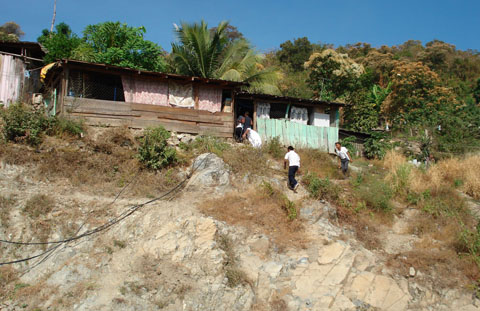 Nueva Creacion primary school is built on a crumbling hillside. "After seeing the dilapidated school buildings we didn't hold out much hope for the Netza school. Boy, were we surprised! These photos tell the story of how SailFest made a significant difference in the lives of children and how it can continue to do more for the poorest children in one of the poorest states in Mexico. For those unable to attend SailFest but who want to donate to this worthy cause, visit www.losninos.us, click on the Donations link, then scroll down to the bottom of the page where you see that Sailfest/Por Los Niños acccepts donations which qualify for tax deductible status. The children of Zihuatanejo appreciate your gift." - latitude / ld & the verderys 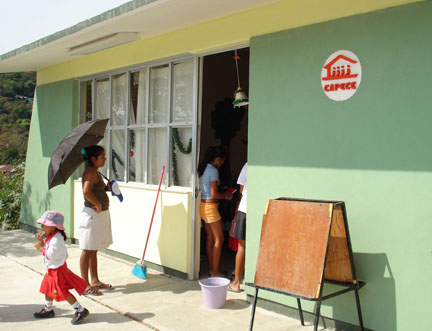 Through the help of cruisers, Netza's students now have new buildings. Photos Courtesy Jellybean |
Dinghy with Knowledge and CareJanuary 24 - St. Barth, F.W.I. In recent issues of Latitude 38, as well as several 'Lectronics, we've warned about the dangers of taking dinghies in and out of the surf, and the dangers of being hit by another boat while riding in a dinghy at night. We've got more evidence to support those warnings. Yesterday afternoon, we sailed over to
Grand Saline, one of St. Barth's nicest beaches, for an afternoon
of boogie-boarding. As we were having fun with the waves, we
looked down the beach and saw two middle-aged men and a woman
trying to launch a 10-ft inflatable with a 4-hp outboard through
small surf. The two men were standing in knee-deep water, while
the woman was sitting in the dinghy. It was between sets, so
the dinghy wasn't getting slammed around very much. But they
were stuck where they were because the two men, obviously inexperienced,
couldn't figure out how to lower the outboard. You know, where
you have to pull the lever and lift the engine head before it
will drop down. Not wanting anyone to get hurt, and needing to atone for countless bad deeds, we hurried down the beach, helped the shaken trio flip the inflatable, showed them how to lower the outboard, and helped them get the rig out through the surf line. They didn't speak English, but it was clear they were grateful for the assistance. While in the Le Select Bar that evening, we heard about a far more tragic dinghy accident that happened here almost exactly a year ago. A French couple had just completed a circumnavigation on a boat of about 37 feet, and were coming ashore in their small inflatable to meet some friends to celebrate. But it was dark, and their dinghy wasn't seen by the French captain of a megayacht, who was coming ashore at high speed in the yacht's tender. He ran over the little dinghy with the circumnavigators, killing the man and badly injuring the woman. His trial is to begin shortly. 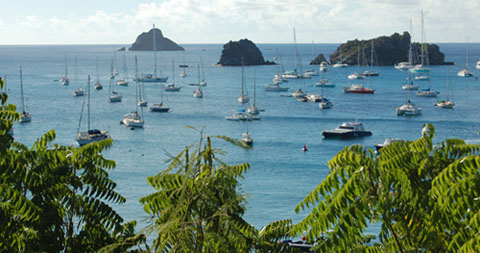 The outer harbor at Gustavia is beautiful and looks peaceful, not at all like a place where innocent cruisers and fishermen have lost their lives. Photo Latitude/Richard Locals told us of at least two other instances in the last 10 years in which people, including a local fishermen, were killed in their dinghies as a result of being hit by larger tenders being operated at high speed. There is a three-knot speed limit in the inner and outer harbors of Gustavia, but it's frequently violated. Our strategy to keep from being killed is to always carry a light and wave it around like crazy to distinguish our dinghy from the ambient lights. We also stick to the sides of the channels and keep our eyes peeled for other fast-moving vessels which often show no lights. In Mexico as in the Caribbean, dinghying defensively is critical. So no matter if coming in or going out through the surf, or dinghying at night, please know what you are doing and be very, very careful. - latitude / rs |